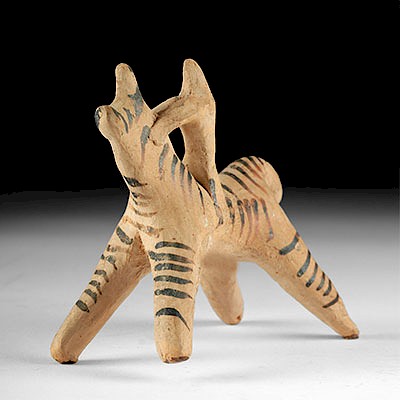Egyptian Predynastic Black-Topped Jar, ex-Parke-Bernet
Lot 1
About Seller
Artemis Fine Arts
686 S Taylor Ave, Ste 106
Louisville, CO 80027
United States
Selling antiquities, ancient and ethnographic art online since 1993, Artemis Gallery specializes in Classical Antiquities (Egyptian, Greek, Roman, Near Eastern), Asian, Pre-Columbian, African / Tribal / Oceanographic art. Our extensive inventory includes pottery, stone, metal, wood, glass and textil...Read more
Estimate:
$5,000 - $7,000
Absentee vs Live bid
Two ways to bid:
- Leave a max absentee bid and the platform will bid on your behalf up to your maximum bid during the live auction.
- Bid live during the auction and your bids will be submitted real-time to the auctioneer.
Bid Increments
| Price | Bid Increment |
|---|---|
| $0 | $25 |
| $300 | $50 |
| $1,000 | $100 |
| $2,000 | $250 |
| $5,000 | $500 |
| $10,000 | $1,000 |
| $20,000 | $2,500 |
| $50,000 | $5,000 |
| $100,000 | $10,000 |
| $200,000 | $20,000 |
About Auction
By Artemis Fine Arts
Oct 25, 2018
Set Reminder
2018-10-25 11:00:00
2018-10-25 11:00:00
America/New_York
Bidsquare
Bidsquare : Antiquities from Egypt, Greece, Italy, Asia
https://www.bidsquare.com/auctions/artemis-gallery/antiquities-from-egypt-greece-italy-asia-3538
Featuring Egyptian, Greek, Roman, Etruscan, Near Eastern, plus Asian art from Central and Far East. If you love the classics, this is the sale for you. Artemis Fine Arts info@artemisgallery.com
Featuring Egyptian, Greek, Roman, Etruscan, Near Eastern, plus Asian art from Central and Far East. If you love the classics, this is the sale for you. Artemis Fine Arts info@artemisgallery.com
- Lot Description
Ancient Egypt, Predynastic Period, Naqada II, ca. 3650 to 3300 BCE. A lovely pottery vessel with a highly-burnished, russet-hued surface made with a thin iron-oxide slip. The coil-formed Nile silt vessel has a short ovoid body with a miniscule base, bulbous walls which gradually taper to a thin rim, and a deep interior cavity. The black-hued area surrounding the rim is comprised of thick carbon deposits formed by subjecting the top to dense clouds of smoke for extended periods of time in an oxygen-deprived environment. Black-top vessels originally rose to popularity during the early Naqada I, a culture which inhabited ancient Egypt during its predynastic period. The Naqada were first described by famed archaeologist William Flinders Petrie; however, relatively little is known about them except that they were focused around the site of El-Amra in central Egypt, west of the Nile river. Lucite display stand for photography purposes only. Size: 3.2" W x 4.75" H (8.1 cm x 12.1 cm).
Pre-Dynastic Egyptian black-top vessels were traditionally made from silt deposits taken from the Nile river due to their abundance in iron and silica. After the pot had dried but before it was fired, it would first be burnished and rubbed smooth with a small stone to create the pinstripe vertical striations still visible today. An iron-rich slip would then be applied just before firing; when placed in an oxygen-rich environment, the elevated temperatures would create the vessel’s signature red-orange hue.
After the end of the Naqada III period around 3,000 BCE, the use of Nile silt in pottery creations fell out of favor with the Pre-Dynastic Egyptians. This is due to the increase in popularity of marl clay, a newly-discovered material for creating terracotta objects which was easier to shape and enabled firing at far greater temperatures than the highly-porous silt.
For a larger, stylistically-similar example, please see The Metropolitan Museum of Art, accession number 36.1.4: https://www.metmuseum.org/art/collection/search/547291
Provenance: private East Coast, USA collection; ex-Royal-Athena Galleries, New York, New York, USA; ex-private Gieringer collection, sold at Parke-Bernet Galleries, New York, USA (January 28-29, 1959, lot 91), acquired by Dr. Richard LeBaron Bowen, Jr., Providence, Rhode Island, USA (1919-2013), thence by descent
All items legal to buy/sell under U.S. Statute covering cultural patrimony Code 2600, CHAPTER 14, and are guaranteed to be as described or your money back.
A Certificate of Authenticity will accompany all winning bids.
We ship worldwide and handle all shipping in-house for your convenience.
#139001Surface wear and abrasions commensurate with age, minor nicks to rim, body, and base, a few stable pressure fissures stemming downward from rim, some fading to pigmentation, and light encrustations, otherwise intact and very good. Nice earthen deposits throughout. Old inventory numbers written in black ink on body exterior.Condition
- Shipping Info
-
All shipping is handled in-house for your convenience. Your invoice from Artemis Gallery will include shipping calculation instructions. If in doubt, please inquire BEFORE bidding for estimated shipping costs for individual items.
-
- Buyer's Premium



 EUR
EUR CAD
CAD AUD
AUD GBP
GBP MXN
MXN HKD
HKD CNY
CNY MYR
MYR SEK
SEK SGD
SGD CHF
CHF THB
THB














